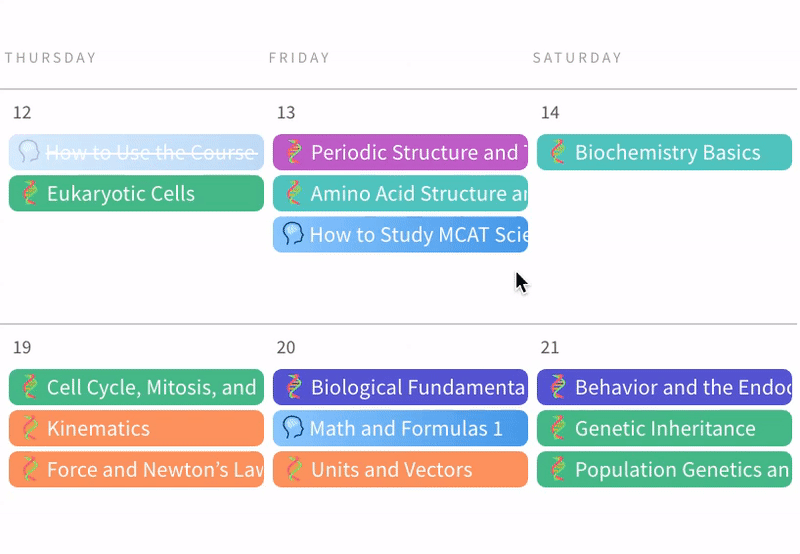
Preparing for the Medical College Admission Test (MCAT) is a marathon, not a sprint. It’s unlike any other test out there, especially those that we’ve become accustomed to in undergrad. I can’t tell you how many times I’ve seen students blindsided by the exam. It’s not necessarily because the topics covered are particularly difficult, but rather, it’s the breadth and quantity of topics that are tested. So, if you’re wondering how long you should study for the MCAT, consider a 6-month MCAT study schedule.
Crafting a 6-Month MCAT Study Schedule
I’m not exaggerating when I say that one of the most common things I cover with my MCAT tutoring students is simply how to study. Unfortunately, that’s one skill that a lot of us don’t develop in college because we’ve never had to truly study before.
Gone are the days of cramming over the weekend for your exam on Monday. Those tests usually focus on one or two topics. At worst, you’re reviewing a semester’s worth of material for a final exam.
The MCAT, on the other hand, essentially tests you on fours years of undergraduate science (and critical reading skills), all at the same time, and you’re not even 100% sure what will or won’t be on the test. Fun!
Free MCAT Resources
📚 A Guide to MCAT Topics and Sections
🔎 How to Study for the MCAT: 10 Evidence-Based Learning Strategies
For MCAT students, a well-structured MCAT study plan is essential. On average, a 6-month MCAT study schedule offers ample time to cover all necessary material without the need to cram at the last minute.
However, no two MCAT students are alike. For this reason, we highly recommend using Blueprint MCAT’s free Study Planner Tool to create your own MCAT study plan tailored specifically to you. But, if you’re not ready to take your first big step in your MCAT prep, we created this high-level outline of a comprehensive study schedule to guide you through each step of your MCAT preparation.
Sample 6-Month MCAT Study Schedule
Phase 1: Content Review Phase (Weeks 1-5)
Laying the Groundwork: Diagnostic MCAT Exam
Your MCAT journey should always begin with a diagnostic exam (Blueprint MCAT offers one for free!). This initial step is crucial for two main reasons.
First, it assesses your current standing with the MCAT. Like we said earlier, the MCAT is unlike any other exam out there so it’s important to get acquainted with the format and the content. Second, it’ll probably scare you into taking your prep a little more seriously once you see what you’re in for. That being said, don’t be disheartened by your MCAT diagnostic score; it’s merely your starting line, not an indicator of your potential.
Personally, I was a non-traditional student and spent about years out of school before going back to take my MCAT. This means I forgot…basically everything. My diagnostic score was ROUGH. I started at a 484 and finished with a 521 MCAT score.
Anything is possible, it just depends on how you study.
Building a Study Plan
With insights from your diagnostic test, construct a personalized study plan. Make it realistic, not idealistic. Life has a bad habit of getting in the way of your prep, so you should try to plan for that.
Consider things like:
- How many hours per week can you dedicate to studying?
- Do you have any other obligations you need to consider (school, work, family, etc).
- Do you anticipate having to take extended time away from your prep due to holidays?
- Is this the best time for you to be studying?
Many students plan their prep over summer break to avoid having to stress about the MCAT and final exams, but that might not be the best time for you, personally. Also, constantly check in with yourself to see if you’re still on track or if things need to be adjusted.
Nothing is set in stone. You can always change your anticipated MCAT test date. Work, school, and life are less forgiving. Remember, flexibility is key. Adjust your plan as you progress.
And because we care, we’re going to plug in our free Study Planner again! If you’re having trouble getting a solid plan together, our free study planner tool takes the guesswork out of what you should be doing on a day-to-day basis!
Choosing MCAT Prep Resources
At this stage, selecting of the right resources is paramount. It shouldn’t come as a surprise that we’d recommend…well, us! Not only does Blueprint MCAT have a comprehensive curriculum and engaging teaching methods, but we offer a variety of study materials tailored to different learning styles, ensuring you have the tools needed to succeed.
Check out our free MCAT resources or compare all our different courses and private tutoring.
There are also a lot of other resources out there that plenty of students make use of, both free and paid. Study apps, official guides, flashcards, etc. The important thing at this point in your prep is that you do your research and find what works best for you.
Content vs. Practice
Once you’ve got your plan all set and ready to go, it’s time to actually start studying. Be sure to prioritize active studying vs passive, and truly aim for comprehension and understanding over rote memorization.
Spaced repetition is also going to be your best friend here. You’ll likely forget a lot of the material you covered over the weeks to come. The ratio of content to practice varies from person to person. However, it should be mostly focused on studying content and learning at this point.
Allocate around 70% of your time to learning new content and 30% to practicing previously covered material to keep it fresh. Also, don’t stress over pacing or full-length practice MCAT exams just yet. In this phase of your 6-month MCAT study schedule, your primary aim is to absorb information like a sponge and reinforce it through targeted practice.
Engage deeply with the material. Use active recall techniques, such as flashcards or teaching concepts back to yourself, to enhance retention. Group studies can also be invaluable at this stage for sharing insights and tackling complex topics collaboratively.
Further Reading
Phase 2: Procedure and Integration Phase (Months 2-4)
Transitioning Focus
After you’ve done your content deep-dive for the first month or so, you should top that phase of your prep with your first full-length practice exam. Here, many of us get our first taste of what a 7.5 hour, critical thinking exam is truly like. Stamina and pacing issues become much more apparent, and an in-depth review of our mistakes starts to become one of the key ways that we identify where we need to improve.
After that first practice MCAT exam, transition to a practice-focused approach. Again, there will be variation from person to person. However, the content-to-practice ratio we mentioned above should be flipped at this point. Now, 60%-70% of your time should be dedicated to practice questions, and 30%-40% focused on content review.
Now’s the time to begin integrating what you’ve learned and applying knowledge in a question-based format. Discrete questions from a Qbank is a great place to start. It’s a fantastic way to quiz yourself to make sure you understand a topic or have your equations memorized.
However, the majority of questions on the MCAT are “passage-based”. This means that just having your facts memorized isn’t enough. You have to also learn how to apply it to new situations.
Timing and Pacing
Remember how I said don’t worry about pacing earlier? Well, now is the point in your 6-month MCAT study schedule when you’ll start to care about incorporating timing into your practice sessions.
We have, on average, 10 minutes to finish an MCAT passage. That breaks down to roughly 4 minutes to read the passage and 60 seconds per question. Oftentimes, when we’re first starting out, we’ll be way above that time limit. It’s not uncommon for a single passage to take us up to 15 minutes to finish in the beginning. Plus, we’ll still be getting plenty of questions wrong as well!
Now, I don’t know about you, but asking me to shave off five minutes, in addition to getting more questions correct, sounds like a pretty tall order. It can be very overwhelming if not downright impossible, which is why I recommend the stopwatch technique.
Instead of having a timer counting down, use a stopwatch to count up. Start the timer as soon as you begin a passage, then set it down and ignore it. Focus on the passage and getting the questions right. Once you finish, pause the timer and look at how long it took you. Regardless of how long it’s taking you, your only goal is to go 15 seconds faster the next time. Then 15 seconds faster after that. So on and so forth for weeks. Eventually, you’re accustomed to finishing passages within the allotted time.
Small incremental improvements are the name of the game here. Learning to manage your time effectively is critical for MCAT success. Begin with untimed practice, gradually moving to timed conditions to build speed without sacrificing accuracy.
Sign up to get expert tips and exclusive invites to free MCAT classes and medical school admissions workshops!
Incorporating Full-Length Exams
This phase of your prep is when you’ll start to regularly integrate practice exams into your study routine, aiming for one every 2-3 weeks. A lot of the time we’re nervous to get a bad score and end up avoiding full-length practice exams. Do. Not. Do. This.
One of the best ways to prep for the MCAT is by taking the MCAT! Who knew?
You’ll probably fall on your face once or twice when taking these exams. That’s okay, it’s even to be expected! If you were ready to take the MCAT, and were hitting your goal score, then you wouldn’t need several more months of training.
These practice exams are not about the score you get. Instead, it’s about familiarizing yourself with the test’s format, understanding the stamina required, and learning from your mistakes. I unironically say that the whole reason we take practice MCAT exams is so we can spend time reviewing them.
In-Depth Review
Reviewing your practice exams are absolutely vital to growing as an MCAT student and increasing your score. This is where you can start to identify gaps in your content knowledge, bad habits, and patterns for which kinds of question types we struggle with.
Again, not to bore you with another shameless plug, but Blueprint MCAT offers in-depth analytics, a digital Lessons Learned Journal, and a powerful AI MCAT tutor named Blue all integrated into your prep resources to make the more meta side of reviewing your exam that much easier.
When it comes to the act of reviewing the test, be sure to complete it within the first three days after you take the exam. Any longer than that and you start to forget why you chose certain answers and it becomes that much harder to identify trends.
Also, don’t stress if it’s taking you a while to review an exam. If it takes 7.5 hours to take the test under extremely strict timed conditions, then it should take you at least as long if not much longer to sit and teach yourself why you missed a question and how to not make that mistake again. Anywhere from 10-12 hours, split over a few days, is totally normal in the beginning. The good news is that as you improve, the time it takes to review an exam will decrease.
I’m not exaggerating when I say that when done properly, in-depth reviewing of full-length exams is one of the most powerful ways to increase your score.
Phase 3: Test Simulation Phase (Months 4-6)
Focusing on AAMC Materials
For the last phase of your prep, you should shift your attention entirely to AAMC practice materials (included with Blueprint Test Prep courses). Qbanks, Qpacks, Diagnostic Tools, and Skills Packs, oh my!
These resources are gold mines for understanding the MCAT’s nuances and will be your bread and butter for the final stretch of your prep. This is also when you can start to get a sense of the particular style the AAMC uses when writing questions.
Weekly AAMC Exams
Here’s where the cortisol hits the fan. The AAMC offers 5 full-length practice MCAT exams. You should definitely complete all of them before taking the real MCAT. We also recommend never taking more than one practice exam per week to avoid burnout.
So, in the final stretch of your 6-month MCAT study schedule, you should take one AAMC exam per week, for the remaining five weeks.
Yes, it’s a LOT. However, this is the make-or-break time before your real exam. Treat these sessions as real test scenarios, adhering to the actual test’s timings and breaks. This will not only acclimate you to the exam conditions but also help in mental conditioning.
Combine these weekly exams with an in-depth review after each one. Complete AAMC practice problems in the days between. Before you know it, you’ll be well on your way to becoming an MCAT expert.
Anecdotally, this is also where most of my students see the biggest improvement in their scores. The only catch is that it isn’t sustainable. This typhoon of practice, review, and more practice will be one of the most mentally exhausting periods of your academic career. If, you try to keep this level of rigor up for more than the final five or so weeks, it’s more than likely to lead to burnout.
Scoring Benchmarks
During this time you need to monitor your practice MCAT scores closely. Aiming to be within 10 points of your goal score a month out and within 5 points two weeks before the exam is a good strategy. Once you’ve hit the same score (plus or minus a few points) two or three times in a row you can safely in assuming that your actual MCAT will be around that same score. These benchmarks are excellent predictors of your actual test performance.
If you’re not sure if you’re ready to take the MCAT, take our quick quiz!
Mental Preparation
Focus on mental conditioning. Confidence, calmness, and clarity under pressure can significantly impact your performance. Maintain a growth mindset to stay motivated. Practice relaxation techniques and ensure you’re well-rested and healthy as the exam approaches.
Final Thoughts
Preparing for the MCAT is undoubtedly a challenging endeavor. For many of us, it’s the most challenging academic struggle we’ve had to face (so far!).
However, approaching it with a structured plan can demystify the process and make your goals attainable. Remember, consistency is key. Stay committed, be flexible in your approach, and maintain a positive attitude.
With diligence and the right strategy, you’ll be well on your way to conquering the MCAT and stepping into the world of medicine. And if at any point you need some pointers, I’d be more than happy to do some 1:1 tutoring!
Search the Blog

Free Consultation
Interested in our Online MCAT Course, One-on-One MCAT Tutoring or Med admissions packages? Set up a free consultation with one of our experienced Senior Student Advisors.
Schedule NowPopular Posts
-
MCAT Blog What's on the MCAT?
-
MCAT Blog How to Review MCAT Full Lengths

Free MCAT Practice Account
Need great MCAT practice?Get the most representative MCAT practice possible when you sign up for our free MCAT Account, which includes a half-length diagnostic exam and one of our full-length MCAT practice exams.
Learn More








